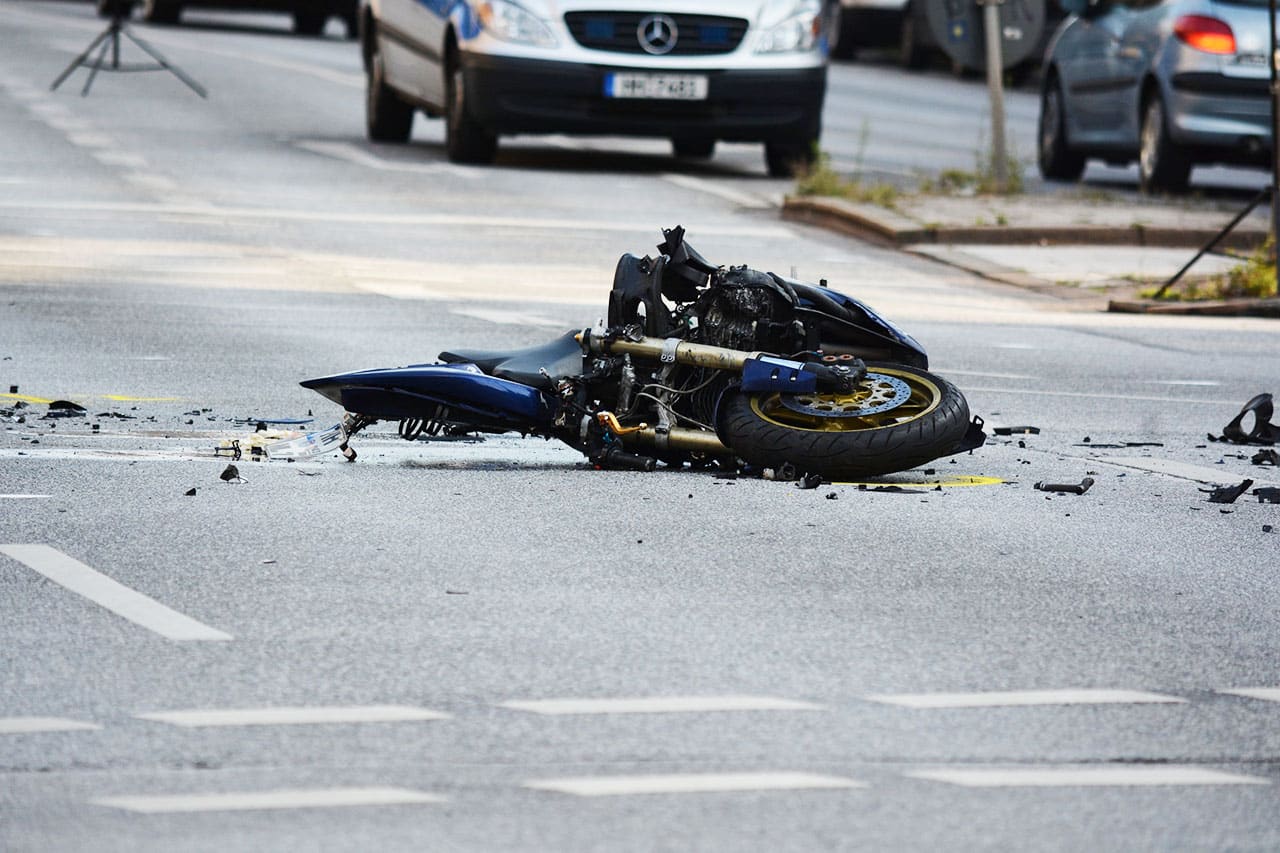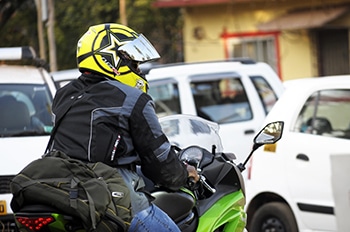
While there are few things more thrilling than eating up the miles from the saddle of your motorbike, there are few things that are more dangerous. Traffic accidents are already a leading cause of death around the world. But motorcyclists are among the most vulnerable as they are less visible and less protected than car drivers.
But exactly how common are motorcycle accidents, what causes them, and what types of injuries are the most common? This article will answer all these questions, as well as look at how you can lower the chances of being injured in a motorcycling accident, and what you should do in the aftermath of an accident.
The statistics on motorcycle accidents, injuries, and mortalities are stark. Approximately 1.35 million people die around the world each year as a result of road traffic accidents. More than half of those accidents involve “vulnerable road users,” which include pedestrians, cyclists, and motorcyclists.
In the United States, motorcycle accidents happen 28 times more often than car accidents, even though motorcyclists only make up 5 percent of people on the road.
Motorcyclists are also around 35 times more likely to die in a traffic accident than the driver of a car. Also, the number of motorcycle fatalities have increased every year for more than a decade. Texas, generally, has the highest number of motorcycle accidents each year, followed by Florida, California, Pennsylvania, and Ohio.
While only around five percent of motorcycle accidents are fatal, the other types of injuries that can result from an accident are serious and can be life changing.
Motorcyclists are at a greater risk of injury because they are less visible than other drivers and, therefore, more likely to be overlooked by other drivers. They also don’t have the protection of the metal frame of the car to prevent injury.
While there is almost no limit to the kind of injury you can suffer as a result of a motorcycle accident, depending on the specific circumstances, some injuries are more common than others. Here are six of the most common injuries motorcyclists suffer as a result of an accident.

While a good-quality helmet will protect against some head injuries, it is still one of the most common types of injuries that occur during motorcycle accidents, as it is one of the most vulnerable parts of our bodies.
As well as cuts to the face and cracked skulls, there is the issue of traumatic brain injuries. This can happen as the result of direct blunt force trauma to the head, which might cause visible injuries.
But severe whiplash or shaking of the head can also cause non-visible brain injuries as the brain impacts against the inside of the skull. This can cause injuries that are completely invisible, and these are often accompanied by symptoms that are both delayed and difficult to recognize.
As well as head injuries, neck injuries are relatively common in motorcycle accidents. These can be relatively mild, such as whiplash, or serious enough to cause permanent paralysis or death.
While road rash might not sound that serious, it can be very painful and have long-term consequences.
Road rash occurs when the rider is thrown from the bike and then skids along the tarmac of the road. This can rip the skin from their body, and depending on the speed of the skidding, the type of road, and the type of clothes that the rider is wearing, this can happen through clothing.
As well as resulting in painful cuts, scrapes, and bruises, it can result in ongoing rashes and skin irritations, and permanent damage to the nerves near the surface of the skin.
These kinds of injuries need to be professionally cleaned and treated after the fact to ensure against infection and complications. Wearing leather that fully covers the body is the best protection against this type of injury.
There are more than 600 muscles in the body, all of which can be damaged by being impacted, pulled, or stretched in the wrong way.
Common types of muscle injuries you are likely to see in the aftermath of a motorcycle accident include sprained wrists and ankles, dislocated shoulders, elbows, and knees, and pulled muscles in any part of the body, but especially the back.
The amount of time these injuries take to heal depends on how serious the injury is, your age and physical shape, and how well you let your body recover after the fact.
When you are involved in a car accident, the seatbelt keeps you in place. This means that, in a mild accident, the most common injuries are bruising to the torso and whiplash of the neck.
However, if you are on a motorcycle, you are likely to be thrown from the motorcycle. When you are thrown in this way, it is human instinct to put your arms out to protect yourself, so you often hit the pavement with your forearms first.
Hitting the ground hard can mean broken arms, but even a lighter impact can lead to serious cuts and bruises and significant nerve damage. This is why arm protection is one of the most important pieces of safety gear a motorcyclist can wear.
As your legs are close to the ground while riding, they often bear the brunt of accidents. Legs and feet can be scraped along the ground, make blunt force impact or get trapped under the weight of the bike.
Shattered and fractured feet, legs, and knees are very common injuries. They are present in 47 percent of motorcycle accidents that receive hospital treatment.
One of the most overlooked injuries associated with motorcycle accidents is emotional trauma. The shock of being involved in an accident can shake you so seriously that it can manifest in Post-Traumatic Stress Disorder (PTSD). You may never feel safe on the road again, and may even struggle to be a passenger on the road in any type of vehicle.

While drivers are generally taught to “watch the road” while driving, motorcyclists are told to watch the cars on the road! This is because most motorcycle accidents are caused by car-motorcycle collisions.
This is not, as many people might imagine, the result of reckless riders weaving in between cars. The reality is, car drivers are taught to look out for other cars, and not for motorcycles. As a result, they often miss them and swerve or stop suddenly in a way that causes accidents.
This is why most motorcycle accidents happen on weekdays during 3 p.m. and 9 p.m. when drivers are tired and making their way home after a long day at work.
For protection, motorcyclists need to be careful not to put themselves somewhere they are likely to be involved in a collision with a car. This means not tailgating, so you won’t be caught out by a car suddenly braking, and keeping out of the blind spot of cars.
Motorcyclists also need to make sure they have the right protective gear. This means a quality helmet that has not been compromised by any small impacts. It also means covering the body with leather to protect the skin, and sturdy gloves and boots to protect the hands and feet. Additional protective gear to protect the arms and the shins is also advisable.
Motorcyclists also need to check their bikes before every ride to ensure all the important parts of the bike are in good working condition before heading out on a ride. This can help prevent any injuries from something going wrong with the bike itself.
Being involved in a motorcycle accident, especially if you have been injured, can make dealing with the aftermath of the incident incredibly challenging. But doing the right thing at the time can save a significant amount of pain and difficulties much later.
If you find yourself in hospital, either because you were rendered unconscious at the scene or your injuries were serious enough that paramedics decided to take you to the hospital, hopefully, you can be grateful for the lifesaving care you have received. But, unfortunately, you will not always be covered by your health insurance.
In addition to ensuring you follow all doctor’s advice to secure your complete and swift recovery, ensure you gather all bills and documentation. These may be vital when it comes to claiming compensation to cover these expenses.
Look After Yourself
If the accident is less serious, and you are conscious and coherent at the site, the first thing you should do is check yourself for injury. This is so you can move away from the road in a way that is safe, taking yourself out of the path of further traffic, while not risking exacerbating injuries by moving an injured part of your body in an inappropriate way.
Contact The Police
But do not leave the scene. Contact the police on an emergency line and report the accident. Provide the police with all the details of the accident and they will decide whether paramedics need to be dispatched, and whether police need to attend the scene.
If the accident is minor, they may ask you to report to a specific location to provide further details of the incident. Make sure you do deliver this information, and get a copy of the associated police report as you may require it for insurance purposes.
Gather Evidence
Exchange details with anyone else involved in the accident and anyone who may have witnessed the incident. If you can, take a record of what any eyewitness saw while it is fresh in their minds. It can also be useful to take photos at the site to record information that may quickly be lost.
Ensure you do not admit any fault to police that might attend the scene, other drivers involved in the accident, or any witnesses. A thoughtless comment at the moment, perhaps intended to make someone else feel better, could hinder your case for damages at a later date should this become an issue.
In the immediate aftermath of an accident, it can be completely normal to feel shaken, upset, and angry, and you may just want to focus on recuperation rather than paperwork. But doing a few key things at this stage can save a significant amount of pain and suffering further down the line.
Consult A Doctor
Even if you do not believe you have been seriously injured, you should take yourself to a doctor.
Some injuries, especially internal injuries, are not obvious, and can be masked by the adrenalin that can accompany the aftermath of an accident. This can be particularly with traumatic brain injuries, the symptoms of which can be subtle, and can be incredibly difficult to self-diagnose because of accompanying brain fog.
A doctor can ensure that all of your injuries are appropriately identified and treated. The medical records created by your doctor may also become important in subsequent damages claims for short-term and long-term medical treatment, as well as pain and suffering.
Speak To Your Insurance Provider
It is important that you file any insurance claims as soon as possible after an accident, as insurance providers often have deadlines for reporting incidents, so by delaying you may miss out on the compensation that you deserve.
Whether you need to submit an insurance claim to your own provider or that of another individual involved in the accident depends on the detail of the accident, but the process is fairly similar. You should provide them with all details of the incident and all documentation associated with the accident, including medical records, medical bills, repair bills, and so forth.
When you are speaking to any insurance provider, even your own, be careful never to admit any guilt within the accident, as agencies concerned with their own bottom line may use this to avoid having to pay out a full claim. It is better to simply refuse to answer questions rather than say anything “incriminating.”
Also, do not forget it is reasonable to add a reasonable amount of money to your claim in order to cover unnecessary pain and suffering as a result of the incident. Two to three times the amount of your total direct expenses is usually considered a reasonable amount for minor injury cases.
Talk To A Lawyer
If you suffer a serious injury, or it appears that the relevant insurance provider is unwilling to cover the full expenses of the accident, you may want to speak to a lawyer.
If the insurance provider starts asking you for unreasonable documentation, refuses to sare documentation or information, or continuously offers delays, these are all signs that they are planning on not fully paying out on the claim.
Contacting a lawyer that is experienced with dealing with this type of case can help you navigate the tricks that insurance companies usually use to avoid payment, tell you how strong your claim is, and help you get the maximum payout to help assist you in your recovery.
At the same time, it is a good idea not to speak to anyone about your claim, as they may provide information on something innocent that you have said that could damage your case. It is also advisable to stay off social media, as anything you post may also be used to damage your case.
The reality of being a motorcyclist is that you are susceptible to injury, so you need to be careful on the road to avoid injury, and careful off the road when dealing with an injury after the fact.
While, hopefully, it is a situation you will never encounter, it is useful for motorcyclists to know what type of motorcycle accidents and injuries are most common, how to avoid them, and what to do if you are unfortunate enough to be involved in an accident.
An experienced South Carolina Motorcycle Accident Attorney
Main Office
PO Box 678 – 1638 Miller Hill Road Lenoir, NC 28645
Phone: (813) 492-7747 | Send us an email

This site uses cookies: Find out more


